Internet of Things and Cyber Crime: Risks and Benefits Essay
VerifiedAdded on 2020/04/29
|14
|3561
|82
Essay
AI Summary
This essay delves into the Internet of Things (IoT), examining its transformative impact on various industries and everyday life. It begins by defining IoT and highlighting its advantages, such as improved efficiency and connectivity, while also addressing the associated risks, particularly those related to cyber crime. The essay provides real-world examples of IoT applications, including smart home devices like Nest and Amazon Echo, and case studies of companies like Stanley Black & Decker and the security breaches faced by Target. It discusses the vulnerabilities of IoT devices to cyber-attacks, data breaches, and hacking, emphasizing the need for robust security measures. The essay concludes by suggesting various strategies to enhance IoT security, including government policies, clear cybersecurity strategies, encryption, and authentication protocols, providing a comprehensive overview of the challenges and opportunities presented by the IoT landscape.
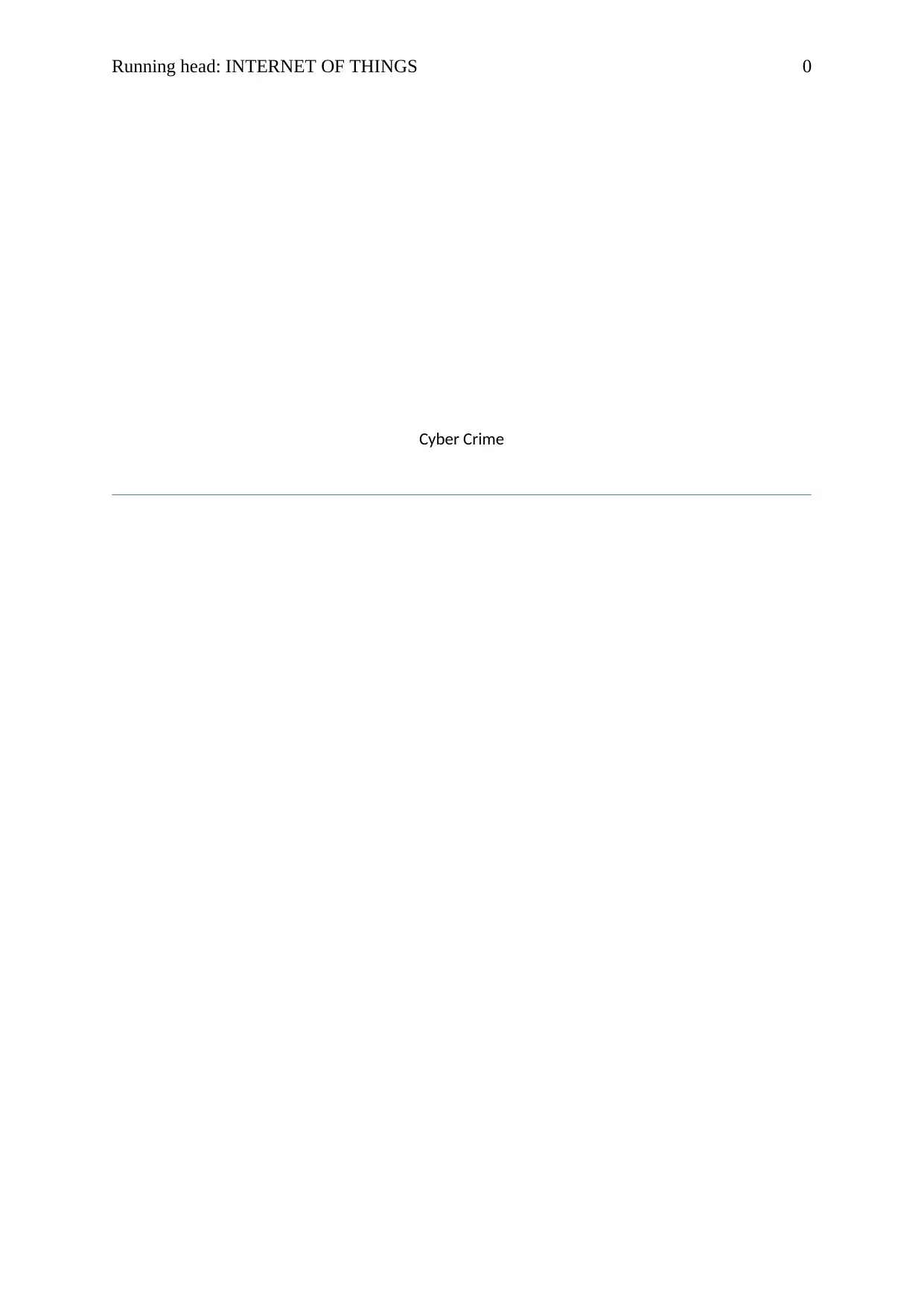
Running head: INTERNET OF THINGS 0
Cyber Crime
Cyber Crime
Paraphrase This Document
Need a fresh take? Get an instant paraphrase of this document with our AI Paraphraser
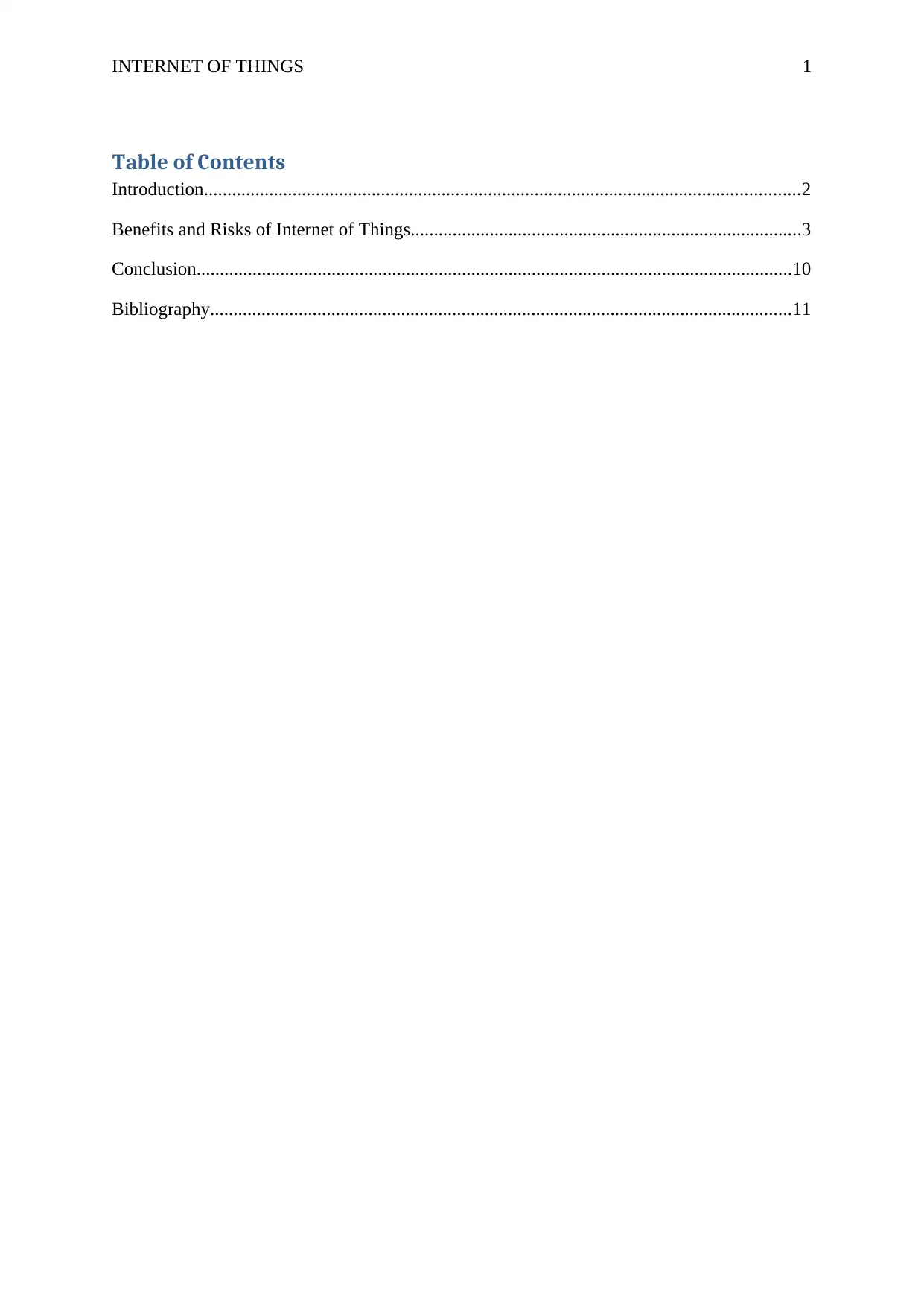
INTERNET OF THINGS 1
Table of Contents
Introduction................................................................................................................................2
Benefits and Risks of Internet of Things....................................................................................3
Conclusion................................................................................................................................10
Bibliography.............................................................................................................................11
Table of Contents
Introduction................................................................................................................................2
Benefits and Risks of Internet of Things....................................................................................3
Conclusion................................................................................................................................10
Bibliography.............................................................................................................................11
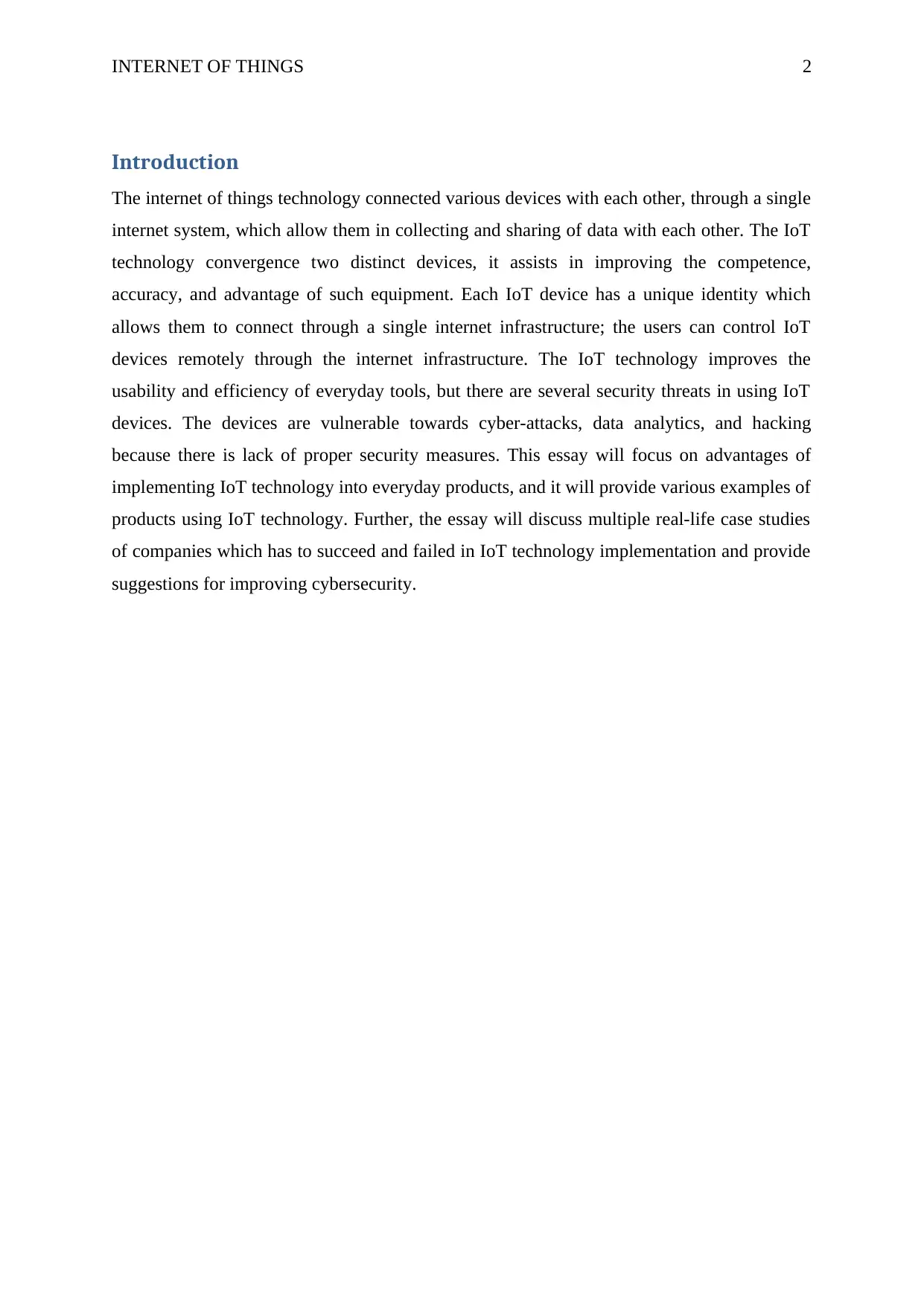
INTERNET OF THINGS 2
Introduction
The internet of things technology connected various devices with each other, through a single
internet system, which allow them in collecting and sharing of data with each other. The IoT
technology convergence two distinct devices, it assists in improving the competence,
accuracy, and advantage of such equipment. Each IoT device has a unique identity which
allows them to connect through a single internet infrastructure; the users can control IoT
devices remotely through the internet infrastructure. The IoT technology improves the
usability and efficiency of everyday tools, but there are several security threats in using IoT
devices. The devices are vulnerable towards cyber-attacks, data analytics, and hacking
because there is lack of proper security measures. This essay will focus on advantages of
implementing IoT technology into everyday products, and it will provide various examples of
products using IoT technology. Further, the essay will discuss multiple real-life case studies
of companies which has to succeed and failed in IoT technology implementation and provide
suggestions for improving cybersecurity.
Introduction
The internet of things technology connected various devices with each other, through a single
internet system, which allow them in collecting and sharing of data with each other. The IoT
technology convergence two distinct devices, it assists in improving the competence,
accuracy, and advantage of such equipment. Each IoT device has a unique identity which
allows them to connect through a single internet infrastructure; the users can control IoT
devices remotely through the internet infrastructure. The IoT technology improves the
usability and efficiency of everyday tools, but there are several security threats in using IoT
devices. The devices are vulnerable towards cyber-attacks, data analytics, and hacking
because there is lack of proper security measures. This essay will focus on advantages of
implementing IoT technology into everyday products, and it will provide various examples of
products using IoT technology. Further, the essay will discuss multiple real-life case studies
of companies which has to succeed and failed in IoT technology implementation and provide
suggestions for improving cybersecurity.
⊘ This is a preview!⊘
Do you want full access?
Subscribe today to unlock all pages.

Trusted by 1+ million students worldwide
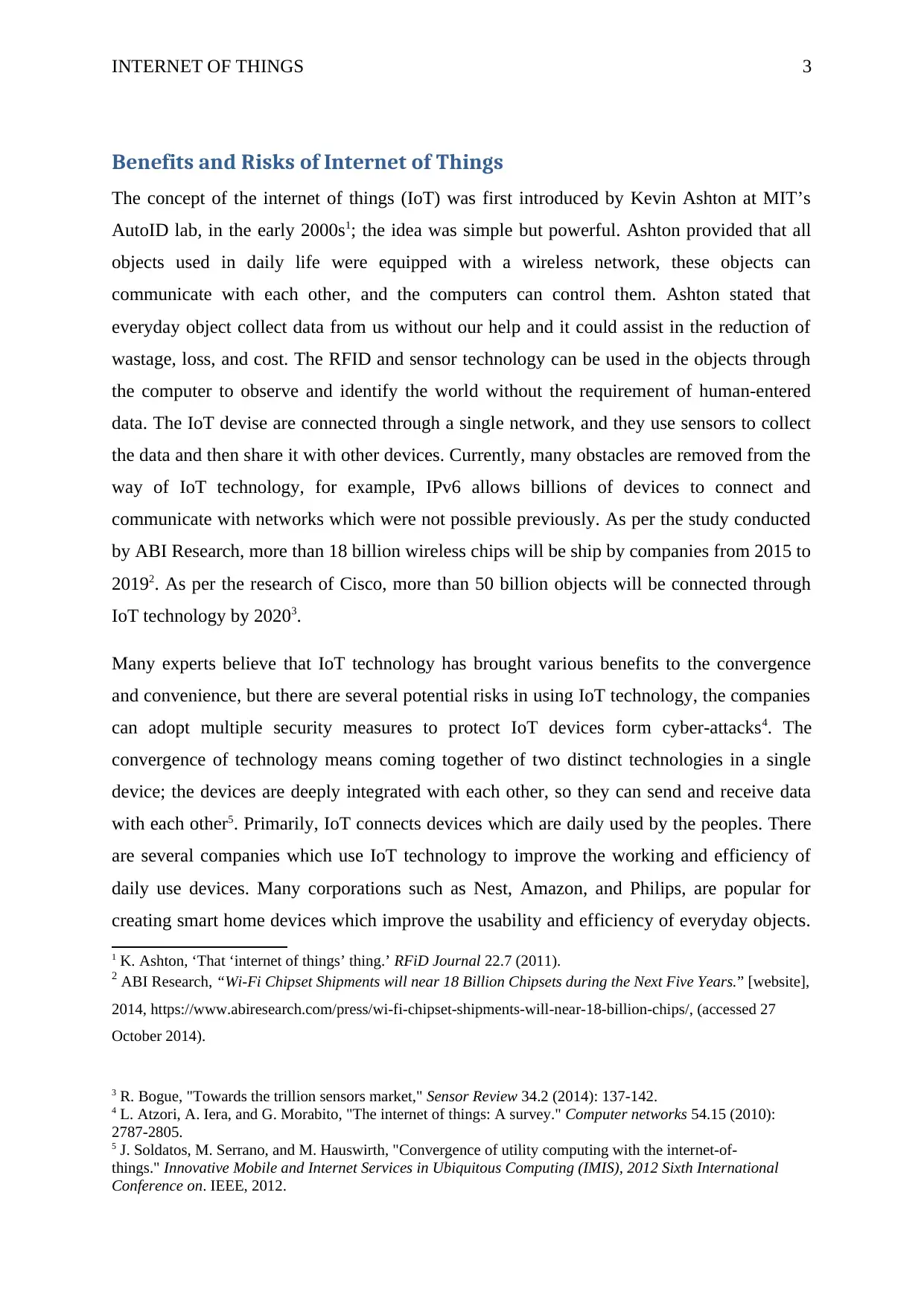
INTERNET OF THINGS 3
Benefits and Risks of Internet of Things
The concept of the internet of things (IoT) was first introduced by Kevin Ashton at MIT’s
AutoID lab, in the early 2000s1; the idea was simple but powerful. Ashton provided that all
objects used in daily life were equipped with a wireless network, these objects can
communicate with each other, and the computers can control them. Ashton stated that
everyday object collect data from us without our help and it could assist in the reduction of
wastage, loss, and cost. The RFID and sensor technology can be used in the objects through
the computer to observe and identify the world without the requirement of human-entered
data. The IoT devise are connected through a single network, and they use sensors to collect
the data and then share it with other devices. Currently, many obstacles are removed from the
way of IoT technology, for example, IPv6 allows billions of devices to connect and
communicate with networks which were not possible previously. As per the study conducted
by ABI Research, more than 18 billion wireless chips will be ship by companies from 2015 to
20192. As per the research of Cisco, more than 50 billion objects will be connected through
IoT technology by 20203.
Many experts believe that IoT technology has brought various benefits to the convergence
and convenience, but there are several potential risks in using IoT technology, the companies
can adopt multiple security measures to protect IoT devices form cyber-attacks4. The
convergence of technology means coming together of two distinct technologies in a single
device; the devices are deeply integrated with each other, so they can send and receive data
with each other5. Primarily, IoT connects devices which are daily used by the peoples. There
are several companies which use IoT technology to improve the working and efficiency of
daily use devices. Many corporations such as Nest, Amazon, and Philips, are popular for
creating smart home devices which improve the usability and efficiency of everyday objects.
1 K. Ashton, ‘That ‘internet of things’ thing.’ RFiD Journal 22.7 (2011).
2 ABI Research, “Wi-Fi Chipset Shipments will near 18 Billion Chipsets during the Next Five Years.” [website],
2014, https://www.abiresearch.com/press/wi-fi-chipset-shipments-will-near-18-billion-chips/, (accessed 27
October 2014).
3 R. Bogue, "Towards the trillion sensors market," Sensor Review 34.2 (2014): 137-142.
4 L. Atzori, A. Iera, and G. Morabito, "The internet of things: A survey." Computer networks 54.15 (2010):
2787-2805.
5 J. Soldatos, M. Serrano, and M. Hauswirth, "Convergence of utility computing with the internet-of-
things." Innovative Mobile and Internet Services in Ubiquitous Computing (IMIS), 2012 Sixth International
Conference on. IEEE, 2012.
Benefits and Risks of Internet of Things
The concept of the internet of things (IoT) was first introduced by Kevin Ashton at MIT’s
AutoID lab, in the early 2000s1; the idea was simple but powerful. Ashton provided that all
objects used in daily life were equipped with a wireless network, these objects can
communicate with each other, and the computers can control them. Ashton stated that
everyday object collect data from us without our help and it could assist in the reduction of
wastage, loss, and cost. The RFID and sensor technology can be used in the objects through
the computer to observe and identify the world without the requirement of human-entered
data. The IoT devise are connected through a single network, and they use sensors to collect
the data and then share it with other devices. Currently, many obstacles are removed from the
way of IoT technology, for example, IPv6 allows billions of devices to connect and
communicate with networks which were not possible previously. As per the study conducted
by ABI Research, more than 18 billion wireless chips will be ship by companies from 2015 to
20192. As per the research of Cisco, more than 50 billion objects will be connected through
IoT technology by 20203.
Many experts believe that IoT technology has brought various benefits to the convergence
and convenience, but there are several potential risks in using IoT technology, the companies
can adopt multiple security measures to protect IoT devices form cyber-attacks4. The
convergence of technology means coming together of two distinct technologies in a single
device; the devices are deeply integrated with each other, so they can send and receive data
with each other5. Primarily, IoT connects devices which are daily used by the peoples. There
are several companies which use IoT technology to improve the working and efficiency of
daily use devices. Many corporations such as Nest, Amazon, and Philips, are popular for
creating smart home devices which improve the usability and efficiency of everyday objects.
1 K. Ashton, ‘That ‘internet of things’ thing.’ RFiD Journal 22.7 (2011).
2 ABI Research, “Wi-Fi Chipset Shipments will near 18 Billion Chipsets during the Next Five Years.” [website],
2014, https://www.abiresearch.com/press/wi-fi-chipset-shipments-will-near-18-billion-chips/, (accessed 27
October 2014).
3 R. Bogue, "Towards the trillion sensors market," Sensor Review 34.2 (2014): 137-142.
4 L. Atzori, A. Iera, and G. Morabito, "The internet of things: A survey." Computer networks 54.15 (2010):
2787-2805.
5 J. Soldatos, M. Serrano, and M. Hauswirth, "Convergence of utility computing with the internet-of-
things." Innovative Mobile and Internet Services in Ubiquitous Computing (IMIS), 2012 Sixth International
Conference on. IEEE, 2012.
Paraphrase This Document
Need a fresh take? Get an instant paraphrase of this document with our AI Paraphraser
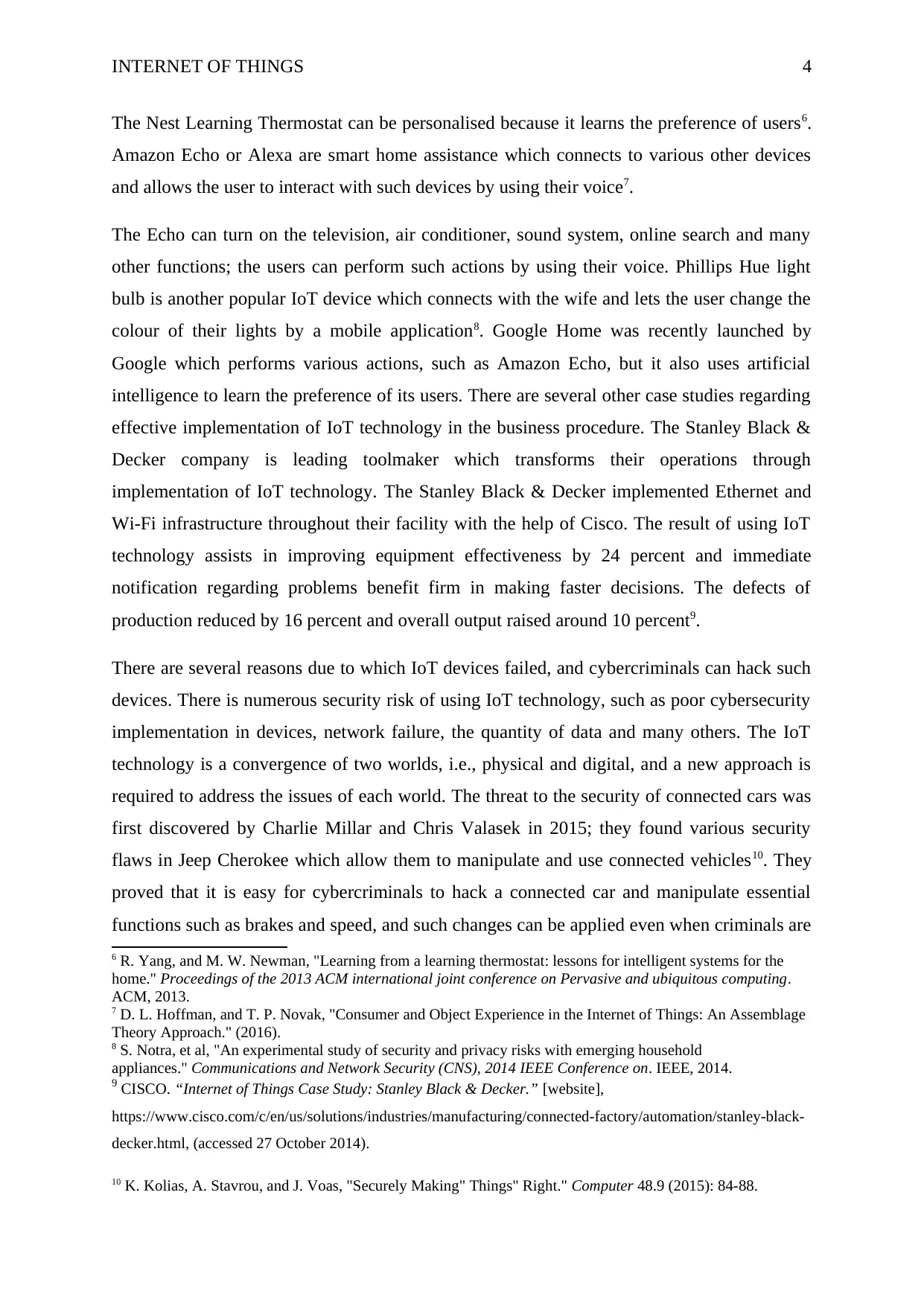
INTERNET OF THINGS 4
The Nest Learning Thermostat can be personalised because it learns the preference of users6.
Amazon Echo or Alexa are smart home assistance which connects to various other devices
and allows the user to interact with such devices by using their voice7.
The Echo can turn on the television, air conditioner, sound system, online search and many
other functions; the users can perform such actions by using their voice. Phillips Hue light
bulb is another popular IoT device which connects with the wife and lets the user change the
colour of their lights by a mobile application8. Google Home was recently launched by
Google which performs various actions, such as Amazon Echo, but it also uses artificial
intelligence to learn the preference of its users. There are several other case studies regarding
effective implementation of IoT technology in the business procedure. The Stanley Black &
Decker company is leading toolmaker which transforms their operations through
implementation of IoT technology. The Stanley Black & Decker implemented Ethernet and
Wi-Fi infrastructure throughout their facility with the help of Cisco. The result of using IoT
technology assists in improving equipment effectiveness by 24 percent and immediate
notification regarding problems benefit firm in making faster decisions. The defects of
production reduced by 16 percent and overall output raised around 10 percent9.
There are several reasons due to which IoT devices failed, and cybercriminals can hack such
devices. There is numerous security risk of using IoT technology, such as poor cybersecurity
implementation in devices, network failure, the quantity of data and many others. The IoT
technology is a convergence of two worlds, i.e., physical and digital, and a new approach is
required to address the issues of each world. The threat to the security of connected cars was
first discovered by Charlie Millar and Chris Valasek in 2015; they found various security
flaws in Jeep Cherokee which allow them to manipulate and use connected vehicles10. They
proved that it is easy for cybercriminals to hack a connected car and manipulate essential
functions such as brakes and speed, and such changes can be applied even when criminals are
6 R. Yang, and M. W. Newman, "Learning from a learning thermostat: lessons for intelligent systems for the
home." Proceedings of the 2013 ACM international joint conference on Pervasive and ubiquitous computing.
ACM, 2013.
7 D. L. Hoffman, and T. P. Novak, "Consumer and Object Experience in the Internet of Things: An Assemblage
Theory Approach." (2016).
8 S. Notra, et al, "An experimental study of security and privacy risks with emerging household
appliances." Communications and Network Security (CNS), 2014 IEEE Conference on. IEEE, 2014.
9 CISCO. “Internet of Things Case Study: Stanley Black & Decker.” [website],
https://www.cisco.com/c/en/us/solutions/industries/manufacturing/connected-factory/automation/stanley-black-
decker.html, (accessed 27 October 2014).
10 K. Kolias, A. Stavrou, and J. Voas, "Securely Making" Things" Right." Computer 48.9 (2015): 84-88.
The Nest Learning Thermostat can be personalised because it learns the preference of users6.
Amazon Echo or Alexa are smart home assistance which connects to various other devices
and allows the user to interact with such devices by using their voice7.
The Echo can turn on the television, air conditioner, sound system, online search and many
other functions; the users can perform such actions by using their voice. Phillips Hue light
bulb is another popular IoT device which connects with the wife and lets the user change the
colour of their lights by a mobile application8. Google Home was recently launched by
Google which performs various actions, such as Amazon Echo, but it also uses artificial
intelligence to learn the preference of its users. There are several other case studies regarding
effective implementation of IoT technology in the business procedure. The Stanley Black &
Decker company is leading toolmaker which transforms their operations through
implementation of IoT technology. The Stanley Black & Decker implemented Ethernet and
Wi-Fi infrastructure throughout their facility with the help of Cisco. The result of using IoT
technology assists in improving equipment effectiveness by 24 percent and immediate
notification regarding problems benefit firm in making faster decisions. The defects of
production reduced by 16 percent and overall output raised around 10 percent9.
There are several reasons due to which IoT devices failed, and cybercriminals can hack such
devices. There is numerous security risk of using IoT technology, such as poor cybersecurity
implementation in devices, network failure, the quantity of data and many others. The IoT
technology is a convergence of two worlds, i.e., physical and digital, and a new approach is
required to address the issues of each world. The threat to the security of connected cars was
first discovered by Charlie Millar and Chris Valasek in 2015; they found various security
flaws in Jeep Cherokee which allow them to manipulate and use connected vehicles10. They
proved that it is easy for cybercriminals to hack a connected car and manipulate essential
functions such as brakes and speed, and such changes can be applied even when criminals are
6 R. Yang, and M. W. Newman, "Learning from a learning thermostat: lessons for intelligent systems for the
home." Proceedings of the 2013 ACM international joint conference on Pervasive and ubiquitous computing.
ACM, 2013.
7 D. L. Hoffman, and T. P. Novak, "Consumer and Object Experience in the Internet of Things: An Assemblage
Theory Approach." (2016).
8 S. Notra, et al, "An experimental study of security and privacy risks with emerging household
appliances." Communications and Network Security (CNS), 2014 IEEE Conference on. IEEE, 2014.
9 CISCO. “Internet of Things Case Study: Stanley Black & Decker.” [website],
https://www.cisco.com/c/en/us/solutions/industries/manufacturing/connected-factory/automation/stanley-black-
decker.html, (accessed 27 October 2014).
10 K. Kolias, A. Stavrou, and J. Voas, "Securely Making" Things" Right." Computer 48.9 (2015): 84-88.
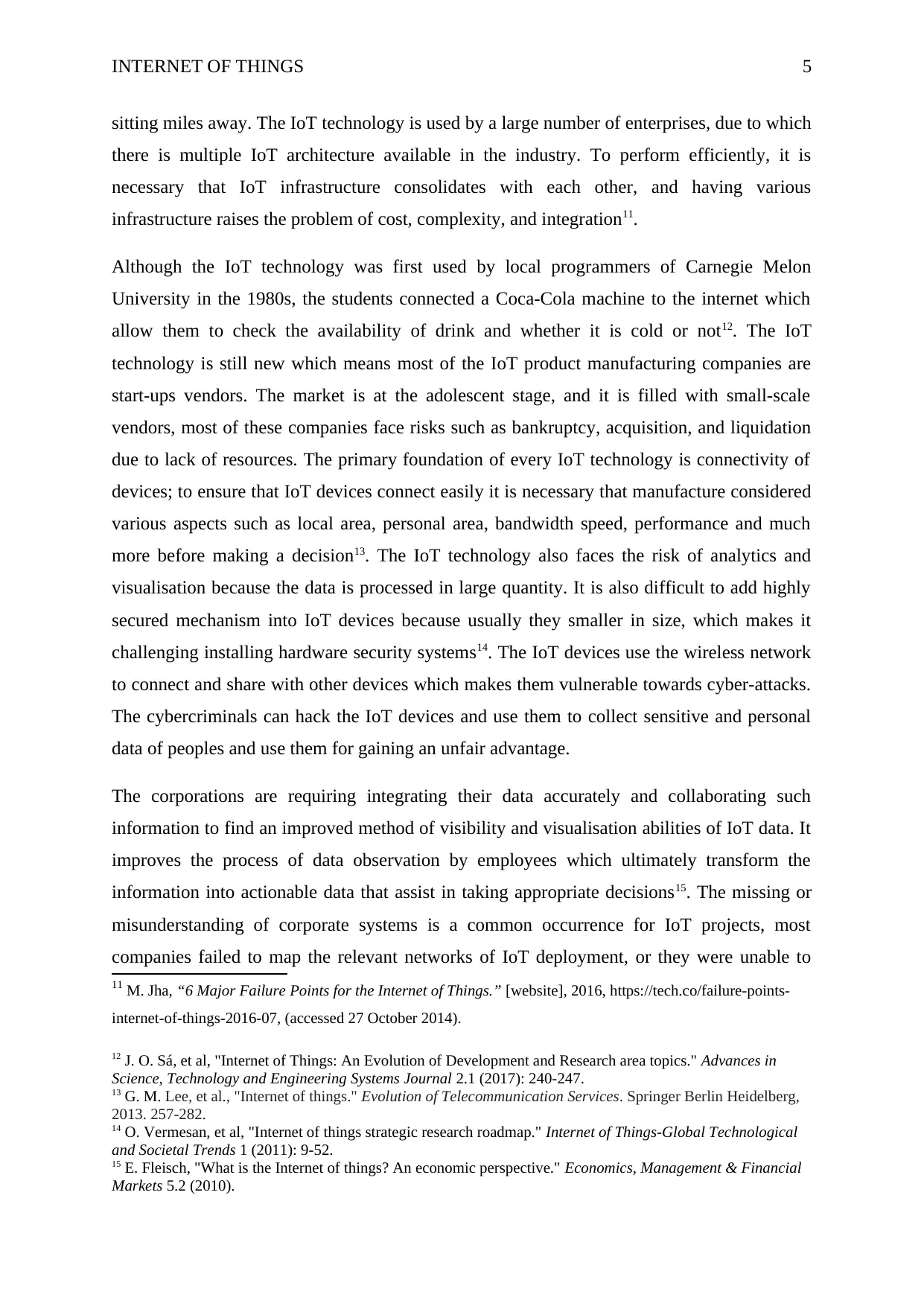
INTERNET OF THINGS 5
sitting miles away. The IoT technology is used by a large number of enterprises, due to which
there is multiple IoT architecture available in the industry. To perform efficiently, it is
necessary that IoT infrastructure consolidates with each other, and having various
infrastructure raises the problem of cost, complexity, and integration11.
Although the IoT technology was first used by local programmers of Carnegie Melon
University in the 1980s, the students connected a Coca-Cola machine to the internet which
allow them to check the availability of drink and whether it is cold or not12. The IoT
technology is still new which means most of the IoT product manufacturing companies are
start-ups vendors. The market is at the adolescent stage, and it is filled with small-scale
vendors, most of these companies face risks such as bankruptcy, acquisition, and liquidation
due to lack of resources. The primary foundation of every IoT technology is connectivity of
devices; to ensure that IoT devices connect easily it is necessary that manufacture considered
various aspects such as local area, personal area, bandwidth speed, performance and much
more before making a decision13. The IoT technology also faces the risk of analytics and
visualisation because the data is processed in large quantity. It is also difficult to add highly
secured mechanism into IoT devices because usually they smaller in size, which makes it
challenging installing hardware security systems14. The IoT devices use the wireless network
to connect and share with other devices which makes them vulnerable towards cyber-attacks.
The cybercriminals can hack the IoT devices and use them to collect sensitive and personal
data of peoples and use them for gaining an unfair advantage.
The corporations are requiring integrating their data accurately and collaborating such
information to find an improved method of visibility and visualisation abilities of IoT data. It
improves the process of data observation by employees which ultimately transform the
information into actionable data that assist in taking appropriate decisions15. The missing or
misunderstanding of corporate systems is a common occurrence for IoT projects, most
companies failed to map the relevant networks of IoT deployment, or they were unable to
11 M. Jha, “6 Major Failure Points for the Internet of Things.” [website], 2016, https://tech.co/failure-points-
internet-of-things-2016-07, (accessed 27 October 2014).
12 J. O. Sá, et al, "Internet of Things: An Evolution of Development and Research area topics." Advances in
Science, Technology and Engineering Systems Journal 2.1 (2017): 240-247.
13 G. M. Lee, et al., "Internet of things." Evolution of Telecommunication Services. Springer Berlin Heidelberg,
2013. 257-282.
14 O. Vermesan, et al, "Internet of things strategic research roadmap." Internet of Things-Global Technological
and Societal Trends 1 (2011): 9-52.
15 E. Fleisch, "What is the Internet of things? An economic perspective." Economics, Management & Financial
Markets 5.2 (2010).
sitting miles away. The IoT technology is used by a large number of enterprises, due to which
there is multiple IoT architecture available in the industry. To perform efficiently, it is
necessary that IoT infrastructure consolidates with each other, and having various
infrastructure raises the problem of cost, complexity, and integration11.
Although the IoT technology was first used by local programmers of Carnegie Melon
University in the 1980s, the students connected a Coca-Cola machine to the internet which
allow them to check the availability of drink and whether it is cold or not12. The IoT
technology is still new which means most of the IoT product manufacturing companies are
start-ups vendors. The market is at the adolescent stage, and it is filled with small-scale
vendors, most of these companies face risks such as bankruptcy, acquisition, and liquidation
due to lack of resources. The primary foundation of every IoT technology is connectivity of
devices; to ensure that IoT devices connect easily it is necessary that manufacture considered
various aspects such as local area, personal area, bandwidth speed, performance and much
more before making a decision13. The IoT technology also faces the risk of analytics and
visualisation because the data is processed in large quantity. It is also difficult to add highly
secured mechanism into IoT devices because usually they smaller in size, which makes it
challenging installing hardware security systems14. The IoT devices use the wireless network
to connect and share with other devices which makes them vulnerable towards cyber-attacks.
The cybercriminals can hack the IoT devices and use them to collect sensitive and personal
data of peoples and use them for gaining an unfair advantage.
The corporations are requiring integrating their data accurately and collaborating such
information to find an improved method of visibility and visualisation abilities of IoT data. It
improves the process of data observation by employees which ultimately transform the
information into actionable data that assist in taking appropriate decisions15. The missing or
misunderstanding of corporate systems is a common occurrence for IoT projects, most
companies failed to map the relevant networks of IoT deployment, or they were unable to
11 M. Jha, “6 Major Failure Points for the Internet of Things.” [website], 2016, https://tech.co/failure-points-
internet-of-things-2016-07, (accessed 27 October 2014).
12 J. O. Sá, et al, "Internet of Things: An Evolution of Development and Research area topics." Advances in
Science, Technology and Engineering Systems Journal 2.1 (2017): 240-247.
13 G. M. Lee, et al., "Internet of things." Evolution of Telecommunication Services. Springer Berlin Heidelberg,
2013. 257-282.
14 O. Vermesan, et al, "Internet of things strategic research roadmap." Internet of Things-Global Technological
and Societal Trends 1 (2011): 9-52.
15 E. Fleisch, "What is the Internet of things? An economic perspective." Economics, Management & Financial
Markets 5.2 (2010).
⊘ This is a preview!⊘
Do you want full access?
Subscribe today to unlock all pages.

Trusted by 1+ million students worldwide
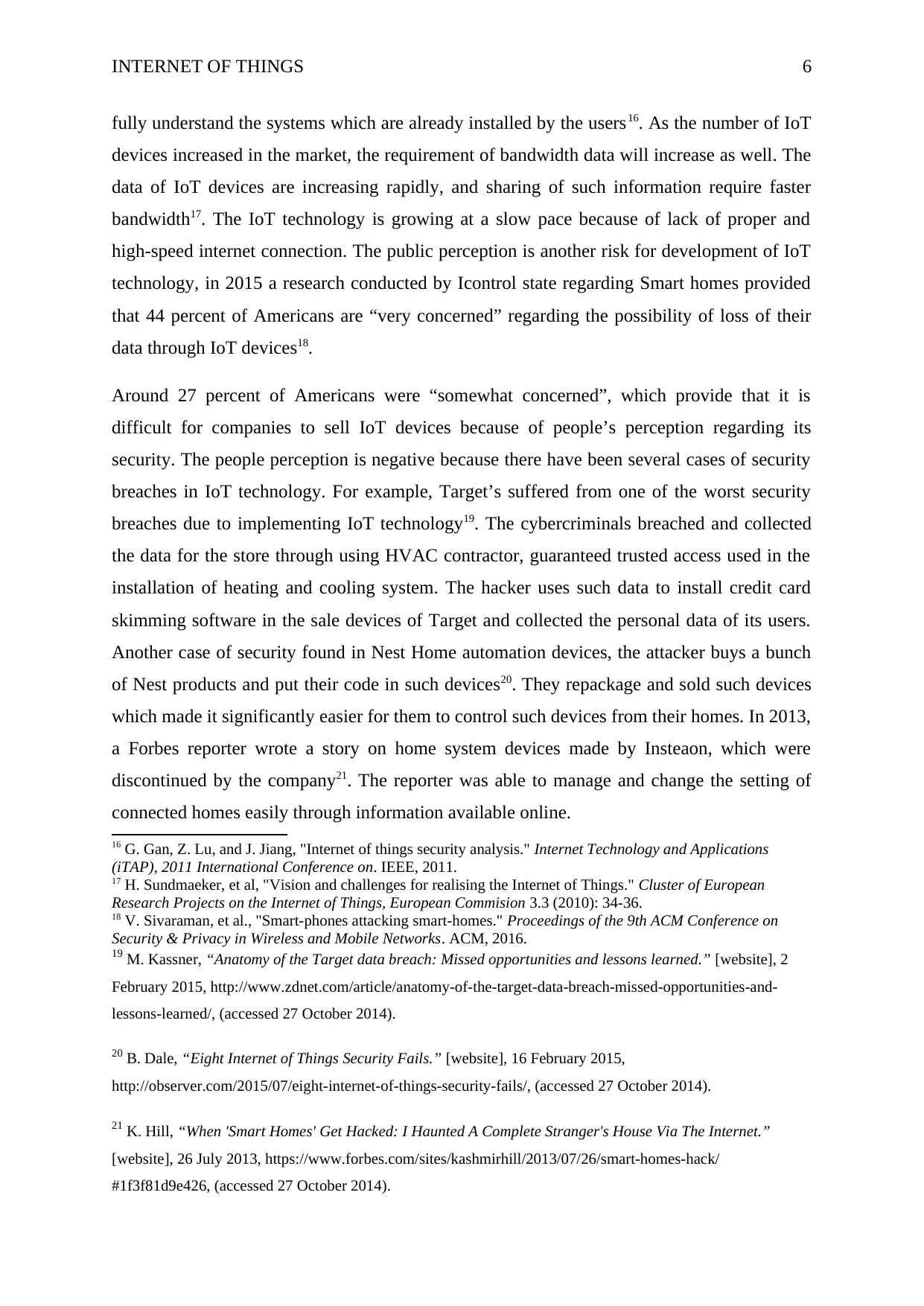
INTERNET OF THINGS 6
fully understand the systems which are already installed by the users16. As the number of IoT
devices increased in the market, the requirement of bandwidth data will increase as well. The
data of IoT devices are increasing rapidly, and sharing of such information require faster
bandwidth17. The IoT technology is growing at a slow pace because of lack of proper and
high-speed internet connection. The public perception is another risk for development of IoT
technology, in 2015 a research conducted by Icontrol state regarding Smart homes provided
that 44 percent of Americans are “very concerned” regarding the possibility of loss of their
data through IoT devices18.
Around 27 percent of Americans were “somewhat concerned”, which provide that it is
difficult for companies to sell IoT devices because of people’s perception regarding its
security. The people perception is negative because there have been several cases of security
breaches in IoT technology. For example, Target’s suffered from one of the worst security
breaches due to implementing IoT technology19. The cybercriminals breached and collected
the data for the store through using HVAC contractor, guaranteed trusted access used in the
installation of heating and cooling system. The hacker uses such data to install credit card
skimming software in the sale devices of Target and collected the personal data of its users.
Another case of security found in Nest Home automation devices, the attacker buys a bunch
of Nest products and put their code in such devices20. They repackage and sold such devices
which made it significantly easier for them to control such devices from their homes. In 2013,
a Forbes reporter wrote a story on home system devices made by Insteaon, which were
discontinued by the company21. The reporter was able to manage and change the setting of
connected homes easily through information available online.
16 G. Gan, Z. Lu, and J. Jiang, "Internet of things security analysis." Internet Technology and Applications
(iTAP), 2011 International Conference on. IEEE, 2011.
17 H. Sundmaeker, et al, "Vision and challenges for realising the Internet of Things." Cluster of European
Research Projects on the Internet of Things, European Commision 3.3 (2010): 34-36.
18 V. Sivaraman, et al., "Smart-phones attacking smart-homes." Proceedings of the 9th ACM Conference on
Security & Privacy in Wireless and Mobile Networks. ACM, 2016.
19 M. Kassner, “Anatomy of the Target data breach: Missed opportunities and lessons learned.” [website], 2
February 2015, http://www.zdnet.com/article/anatomy-of-the-target-data-breach-missed-opportunities-and-
lessons-learned/, (accessed 27 October 2014).
20 B. Dale, “Eight Internet of Things Security Fails.” [website], 16 February 2015,
http://observer.com/2015/07/eight-internet-of-things-security-fails/, (accessed 27 October 2014).
21 K. Hill, “When 'Smart Homes' Get Hacked: I Haunted A Complete Stranger's House Via The Internet.”
[website], 26 July 2013, https://www.forbes.com/sites/kashmirhill/2013/07/26/smart-homes-hack/
#1f3f81d9e426, (accessed 27 October 2014).
fully understand the systems which are already installed by the users16. As the number of IoT
devices increased in the market, the requirement of bandwidth data will increase as well. The
data of IoT devices are increasing rapidly, and sharing of such information require faster
bandwidth17. The IoT technology is growing at a slow pace because of lack of proper and
high-speed internet connection. The public perception is another risk for development of IoT
technology, in 2015 a research conducted by Icontrol state regarding Smart homes provided
that 44 percent of Americans are “very concerned” regarding the possibility of loss of their
data through IoT devices18.
Around 27 percent of Americans were “somewhat concerned”, which provide that it is
difficult for companies to sell IoT devices because of people’s perception regarding its
security. The people perception is negative because there have been several cases of security
breaches in IoT technology. For example, Target’s suffered from one of the worst security
breaches due to implementing IoT technology19. The cybercriminals breached and collected
the data for the store through using HVAC contractor, guaranteed trusted access used in the
installation of heating and cooling system. The hacker uses such data to install credit card
skimming software in the sale devices of Target and collected the personal data of its users.
Another case of security found in Nest Home automation devices, the attacker buys a bunch
of Nest products and put their code in such devices20. They repackage and sold such devices
which made it significantly easier for them to control such devices from their homes. In 2013,
a Forbes reporter wrote a story on home system devices made by Insteaon, which were
discontinued by the company21. The reporter was able to manage and change the setting of
connected homes easily through information available online.
16 G. Gan, Z. Lu, and J. Jiang, "Internet of things security analysis." Internet Technology and Applications
(iTAP), 2011 International Conference on. IEEE, 2011.
17 H. Sundmaeker, et al, "Vision and challenges for realising the Internet of Things." Cluster of European
Research Projects on the Internet of Things, European Commision 3.3 (2010): 34-36.
18 V. Sivaraman, et al., "Smart-phones attacking smart-homes." Proceedings of the 9th ACM Conference on
Security & Privacy in Wireless and Mobile Networks. ACM, 2016.
19 M. Kassner, “Anatomy of the Target data breach: Missed opportunities and lessons learned.” [website], 2
February 2015, http://www.zdnet.com/article/anatomy-of-the-target-data-breach-missed-opportunities-and-
lessons-learned/, (accessed 27 October 2014).
20 B. Dale, “Eight Internet of Things Security Fails.” [website], 16 February 2015,
http://observer.com/2015/07/eight-internet-of-things-security-fails/, (accessed 27 October 2014).
21 K. Hill, “When 'Smart Homes' Get Hacked: I Haunted A Complete Stranger's House Via The Internet.”
[website], 26 July 2013, https://www.forbes.com/sites/kashmirhill/2013/07/26/smart-homes-hack/
#1f3f81d9e426, (accessed 27 October 2014).
Paraphrase This Document
Need a fresh take? Get an instant paraphrase of this document with our AI Paraphraser
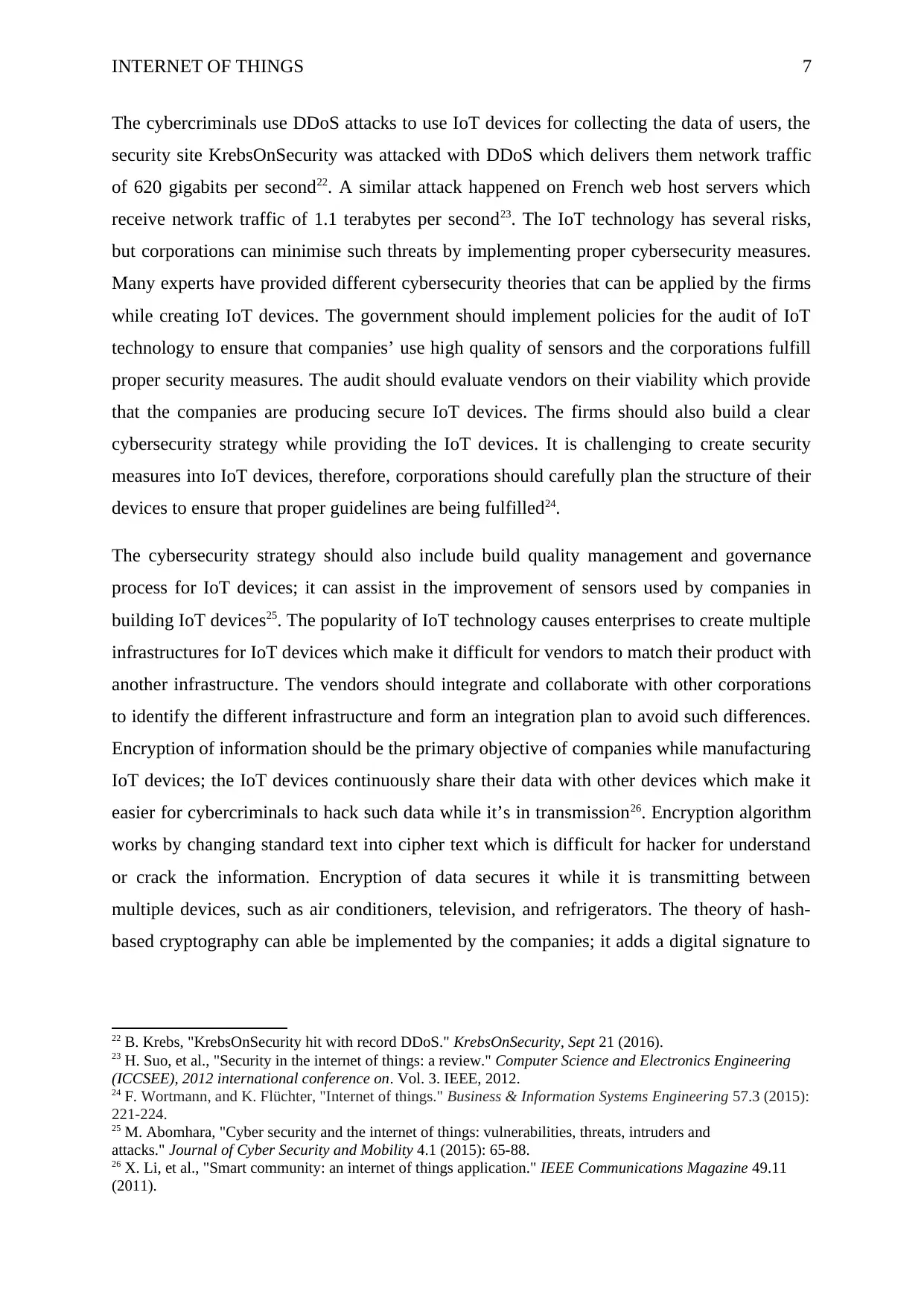
INTERNET OF THINGS 7
The cybercriminals use DDoS attacks to use IoT devices for collecting the data of users, the
security site KrebsOnSecurity was attacked with DDoS which delivers them network traffic
of 620 gigabits per second22. A similar attack happened on French web host servers which
receive network traffic of 1.1 terabytes per second23. The IoT technology has several risks,
but corporations can minimise such threats by implementing proper cybersecurity measures.
Many experts have provided different cybersecurity theories that can be applied by the firms
while creating IoT devices. The government should implement policies for the audit of IoT
technology to ensure that companies’ use high quality of sensors and the corporations fulfill
proper security measures. The audit should evaluate vendors on their viability which provide
that the companies are producing secure IoT devices. The firms should also build a clear
cybersecurity strategy while providing the IoT devices. It is challenging to create security
measures into IoT devices, therefore, corporations should carefully plan the structure of their
devices to ensure that proper guidelines are being fulfilled24.
The cybersecurity strategy should also include build quality management and governance
process for IoT devices; it can assist in the improvement of sensors used by companies in
building IoT devices25. The popularity of IoT technology causes enterprises to create multiple
infrastructures for IoT devices which make it difficult for vendors to match their product with
another infrastructure. The vendors should integrate and collaborate with other corporations
to identify the different infrastructure and form an integration plan to avoid such differences.
Encryption of information should be the primary objective of companies while manufacturing
IoT devices; the IoT devices continuously share their data with other devices which make it
easier for cybercriminals to hack such data while it’s in transmission26. Encryption algorithm
works by changing standard text into cipher text which is difficult for hacker for understand
or crack the information. Encryption of data secures it while it is transmitting between
multiple devices, such as air conditioners, television, and refrigerators. The theory of hash-
based cryptography can able be implemented by the companies; it adds a digital signature to
22 B. Krebs, "KrebsOnSecurity hit with record DDoS." KrebsOnSecurity, Sept 21 (2016).
23 H. Suo, et al., "Security in the internet of things: a review." Computer Science and Electronics Engineering
(ICCSEE), 2012 international conference on. Vol. 3. IEEE, 2012.
24 F. Wortmann, and K. Flüchter, "Internet of things." Business & Information Systems Engineering 57.3 (2015):
221-224.
25 M. Abomhara, "Cyber security and the internet of things: vulnerabilities, threats, intruders and
attacks." Journal of Cyber Security and Mobility 4.1 (2015): 65-88.
26 X. Li, et al., "Smart community: an internet of things application." IEEE Communications Magazine 49.11
(2011).
The cybercriminals use DDoS attacks to use IoT devices for collecting the data of users, the
security site KrebsOnSecurity was attacked with DDoS which delivers them network traffic
of 620 gigabits per second22. A similar attack happened on French web host servers which
receive network traffic of 1.1 terabytes per second23. The IoT technology has several risks,
but corporations can minimise such threats by implementing proper cybersecurity measures.
Many experts have provided different cybersecurity theories that can be applied by the firms
while creating IoT devices. The government should implement policies for the audit of IoT
technology to ensure that companies’ use high quality of sensors and the corporations fulfill
proper security measures. The audit should evaluate vendors on their viability which provide
that the companies are producing secure IoT devices. The firms should also build a clear
cybersecurity strategy while providing the IoT devices. It is challenging to create security
measures into IoT devices, therefore, corporations should carefully plan the structure of their
devices to ensure that proper guidelines are being fulfilled24.
The cybersecurity strategy should also include build quality management and governance
process for IoT devices; it can assist in the improvement of sensors used by companies in
building IoT devices25. The popularity of IoT technology causes enterprises to create multiple
infrastructures for IoT devices which make it difficult for vendors to match their product with
another infrastructure. The vendors should integrate and collaborate with other corporations
to identify the different infrastructure and form an integration plan to avoid such differences.
Encryption of information should be the primary objective of companies while manufacturing
IoT devices; the IoT devices continuously share their data with other devices which make it
easier for cybercriminals to hack such data while it’s in transmission26. Encryption algorithm
works by changing standard text into cipher text which is difficult for hacker for understand
or crack the information. Encryption of data secures it while it is transmitting between
multiple devices, such as air conditioners, television, and refrigerators. The theory of hash-
based cryptography can able be implemented by the companies; it adds a digital signature to
22 B. Krebs, "KrebsOnSecurity hit with record DDoS." KrebsOnSecurity, Sept 21 (2016).
23 H. Suo, et al., "Security in the internet of things: a review." Computer Science and Electronics Engineering
(ICCSEE), 2012 international conference on. Vol. 3. IEEE, 2012.
24 F. Wortmann, and K. Flüchter, "Internet of things." Business & Information Systems Engineering 57.3 (2015):
221-224.
25 M. Abomhara, "Cyber security and the internet of things: vulnerabilities, threats, intruders and
attacks." Journal of Cyber Security and Mobility 4.1 (2015): 65-88.
26 X. Li, et al., "Smart community: an internet of things application." IEEE Communications Magazine 49.11
(2011).
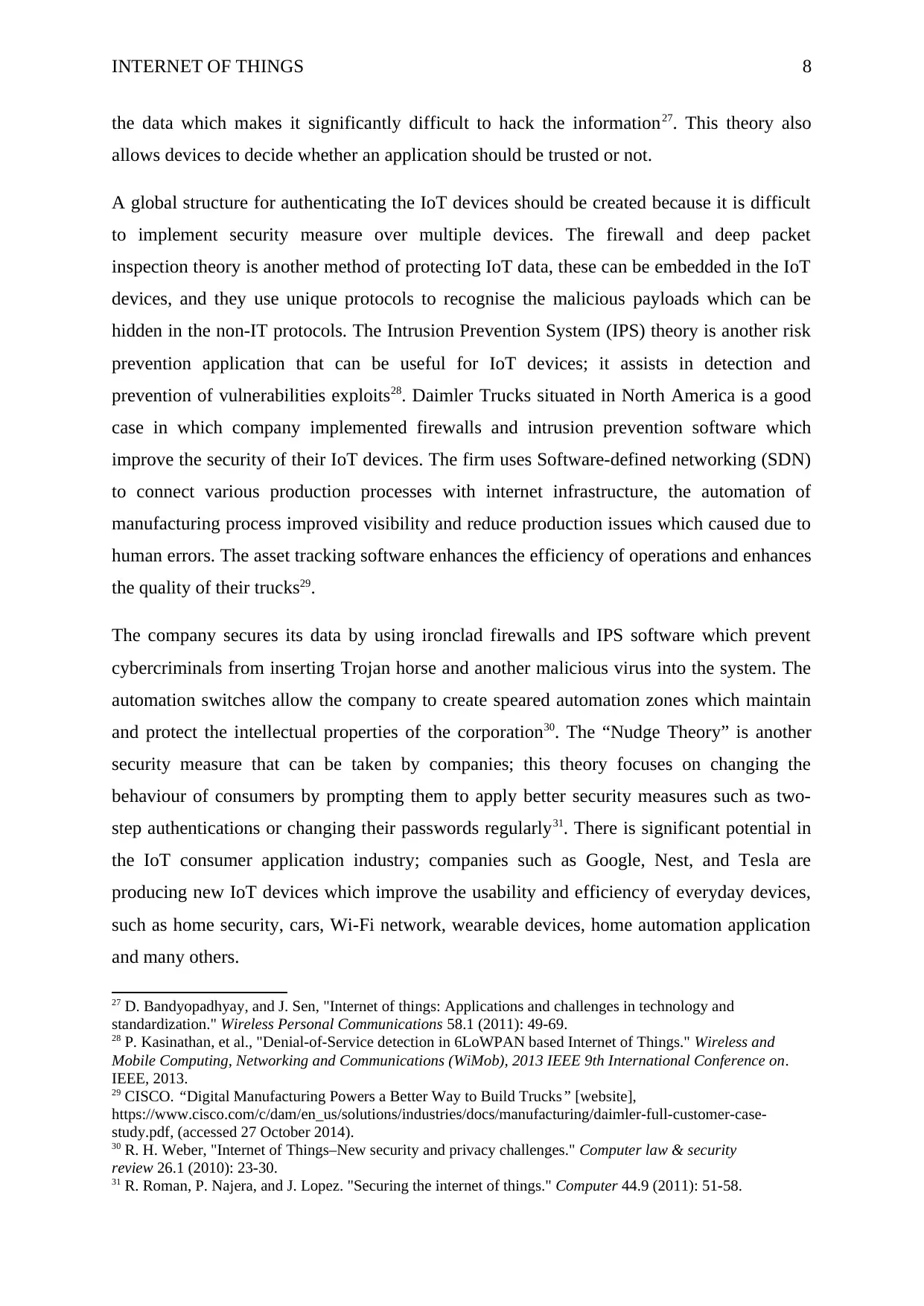
INTERNET OF THINGS 8
the data which makes it significantly difficult to hack the information27. This theory also
allows devices to decide whether an application should be trusted or not.
A global structure for authenticating the IoT devices should be created because it is difficult
to implement security measure over multiple devices. The firewall and deep packet
inspection theory is another method of protecting IoT data, these can be embedded in the IoT
devices, and they use unique protocols to recognise the malicious payloads which can be
hidden in the non-IT protocols. The Intrusion Prevention System (IPS) theory is another risk
prevention application that can be useful for IoT devices; it assists in detection and
prevention of vulnerabilities exploits28. Daimler Trucks situated in North America is a good
case in which company implemented firewalls and intrusion prevention software which
improve the security of their IoT devices. The firm uses Software-defined networking (SDN)
to connect various production processes with internet infrastructure, the automation of
manufacturing process improved visibility and reduce production issues which caused due to
human errors. The asset tracking software enhances the efficiency of operations and enhances
the quality of their trucks29.
The company secures its data by using ironclad firewalls and IPS software which prevent
cybercriminals from inserting Trojan horse and another malicious virus into the system. The
automation switches allow the company to create speared automation zones which maintain
and protect the intellectual properties of the corporation30. The “Nudge Theory” is another
security measure that can be taken by companies; this theory focuses on changing the
behaviour of consumers by prompting them to apply better security measures such as two-
step authentications or changing their passwords regularly31. There is significant potential in
the IoT consumer application industry; companies such as Google, Nest, and Tesla are
producing new IoT devices which improve the usability and efficiency of everyday devices,
such as home security, cars, Wi-Fi network, wearable devices, home automation application
and many others.
27 D. Bandyopadhyay, and J. Sen, "Internet of things: Applications and challenges in technology and
standardization." Wireless Personal Communications 58.1 (2011): 49-69.
28 P. Kasinathan, et al., "Denial-of-Service detection in 6LoWPAN based Internet of Things." Wireless and
Mobile Computing, Networking and Communications (WiMob), 2013 IEEE 9th International Conference on.
IEEE, 2013.
29 CISCO. “Digital Manufacturing Powers a Better Way to Build Trucks” [website],
https://www.cisco.com/c/dam/en_us/solutions/industries/docs/manufacturing/daimler-full-customer-case-
study.pdf, (accessed 27 October 2014).
30 R. H. Weber, "Internet of Things–New security and privacy challenges." Computer law & security
review 26.1 (2010): 23-30.
31 R. Roman, P. Najera, and J. Lopez. "Securing the internet of things." Computer 44.9 (2011): 51-58.
the data which makes it significantly difficult to hack the information27. This theory also
allows devices to decide whether an application should be trusted or not.
A global structure for authenticating the IoT devices should be created because it is difficult
to implement security measure over multiple devices. The firewall and deep packet
inspection theory is another method of protecting IoT data, these can be embedded in the IoT
devices, and they use unique protocols to recognise the malicious payloads which can be
hidden in the non-IT protocols. The Intrusion Prevention System (IPS) theory is another risk
prevention application that can be useful for IoT devices; it assists in detection and
prevention of vulnerabilities exploits28. Daimler Trucks situated in North America is a good
case in which company implemented firewalls and intrusion prevention software which
improve the security of their IoT devices. The firm uses Software-defined networking (SDN)
to connect various production processes with internet infrastructure, the automation of
manufacturing process improved visibility and reduce production issues which caused due to
human errors. The asset tracking software enhances the efficiency of operations and enhances
the quality of their trucks29.
The company secures its data by using ironclad firewalls and IPS software which prevent
cybercriminals from inserting Trojan horse and another malicious virus into the system. The
automation switches allow the company to create speared automation zones which maintain
and protect the intellectual properties of the corporation30. The “Nudge Theory” is another
security measure that can be taken by companies; this theory focuses on changing the
behaviour of consumers by prompting them to apply better security measures such as two-
step authentications or changing their passwords regularly31. There is significant potential in
the IoT consumer application industry; companies such as Google, Nest, and Tesla are
producing new IoT devices which improve the usability and efficiency of everyday devices,
such as home security, cars, Wi-Fi network, wearable devices, home automation application
and many others.
27 D. Bandyopadhyay, and J. Sen, "Internet of things: Applications and challenges in technology and
standardization." Wireless Personal Communications 58.1 (2011): 49-69.
28 P. Kasinathan, et al., "Denial-of-Service detection in 6LoWPAN based Internet of Things." Wireless and
Mobile Computing, Networking and Communications (WiMob), 2013 IEEE 9th International Conference on.
IEEE, 2013.
29 CISCO. “Digital Manufacturing Powers a Better Way to Build Trucks” [website],
https://www.cisco.com/c/dam/en_us/solutions/industries/docs/manufacturing/daimler-full-customer-case-
study.pdf, (accessed 27 October 2014).
30 R. H. Weber, "Internet of Things–New security and privacy challenges." Computer law & security
review 26.1 (2010): 23-30.
31 R. Roman, P. Najera, and J. Lopez. "Securing the internet of things." Computer 44.9 (2011): 51-58.
⊘ This is a preview!⊘
Do you want full access?
Subscribe today to unlock all pages.

Trusted by 1+ million students worldwide

INTERNET OF THINGS 9
Paraphrase This Document
Need a fresh take? Get an instant paraphrase of this document with our AI Paraphraser
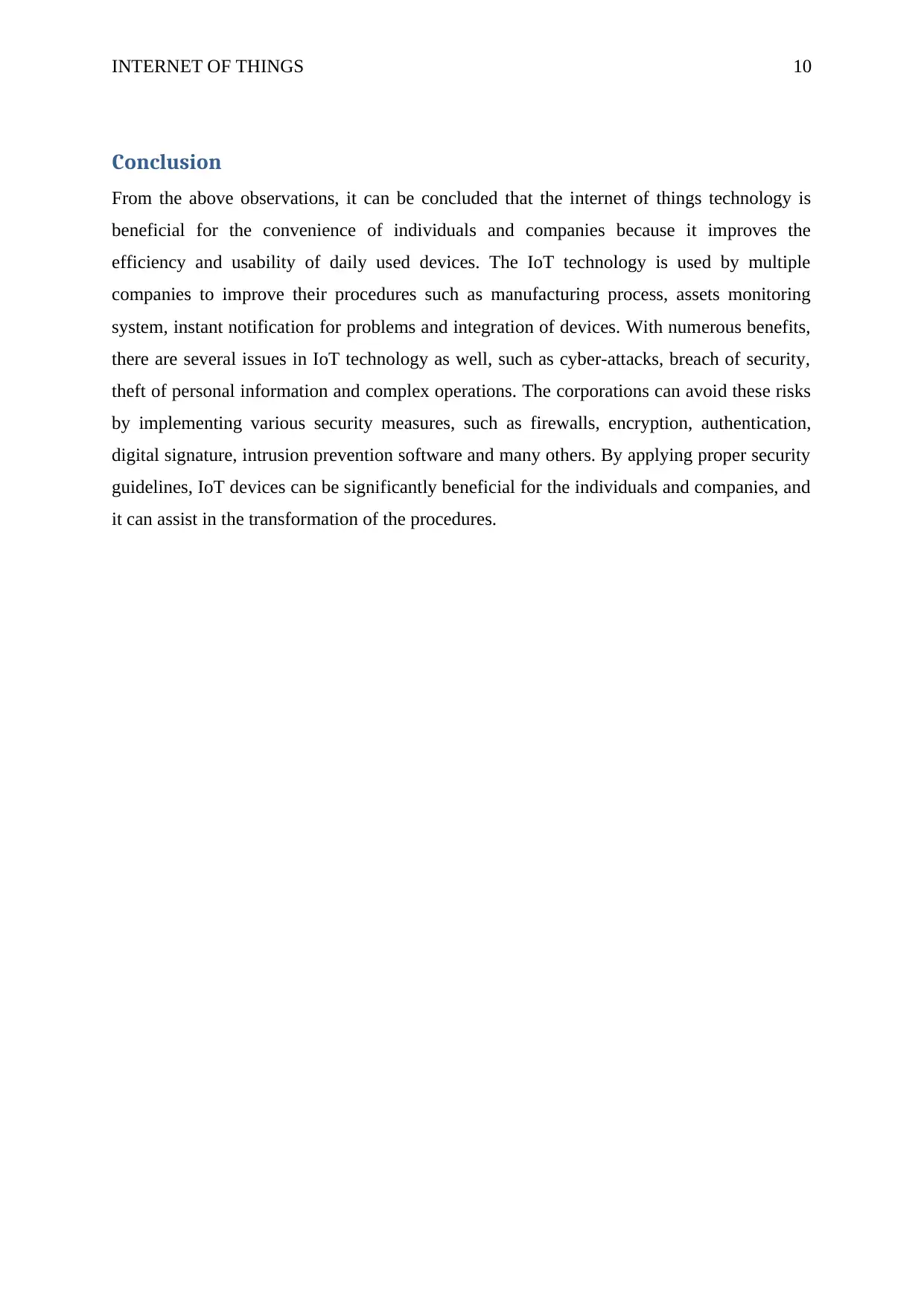
INTERNET OF THINGS 10
Conclusion
From the above observations, it can be concluded that the internet of things technology is
beneficial for the convenience of individuals and companies because it improves the
efficiency and usability of daily used devices. The IoT technology is used by multiple
companies to improve their procedures such as manufacturing process, assets monitoring
system, instant notification for problems and integration of devices. With numerous benefits,
there are several issues in IoT technology as well, such as cyber-attacks, breach of security,
theft of personal information and complex operations. The corporations can avoid these risks
by implementing various security measures, such as firewalls, encryption, authentication,
digital signature, intrusion prevention software and many others. By applying proper security
guidelines, IoT devices can be significantly beneficial for the individuals and companies, and
it can assist in the transformation of the procedures.
Conclusion
From the above observations, it can be concluded that the internet of things technology is
beneficial for the convenience of individuals and companies because it improves the
efficiency and usability of daily used devices. The IoT technology is used by multiple
companies to improve their procedures such as manufacturing process, assets monitoring
system, instant notification for problems and integration of devices. With numerous benefits,
there are several issues in IoT technology as well, such as cyber-attacks, breach of security,
theft of personal information and complex operations. The corporations can avoid these risks
by implementing various security measures, such as firewalls, encryption, authentication,
digital signature, intrusion prevention software and many others. By applying proper security
guidelines, IoT devices can be significantly beneficial for the individuals and companies, and
it can assist in the transformation of the procedures.
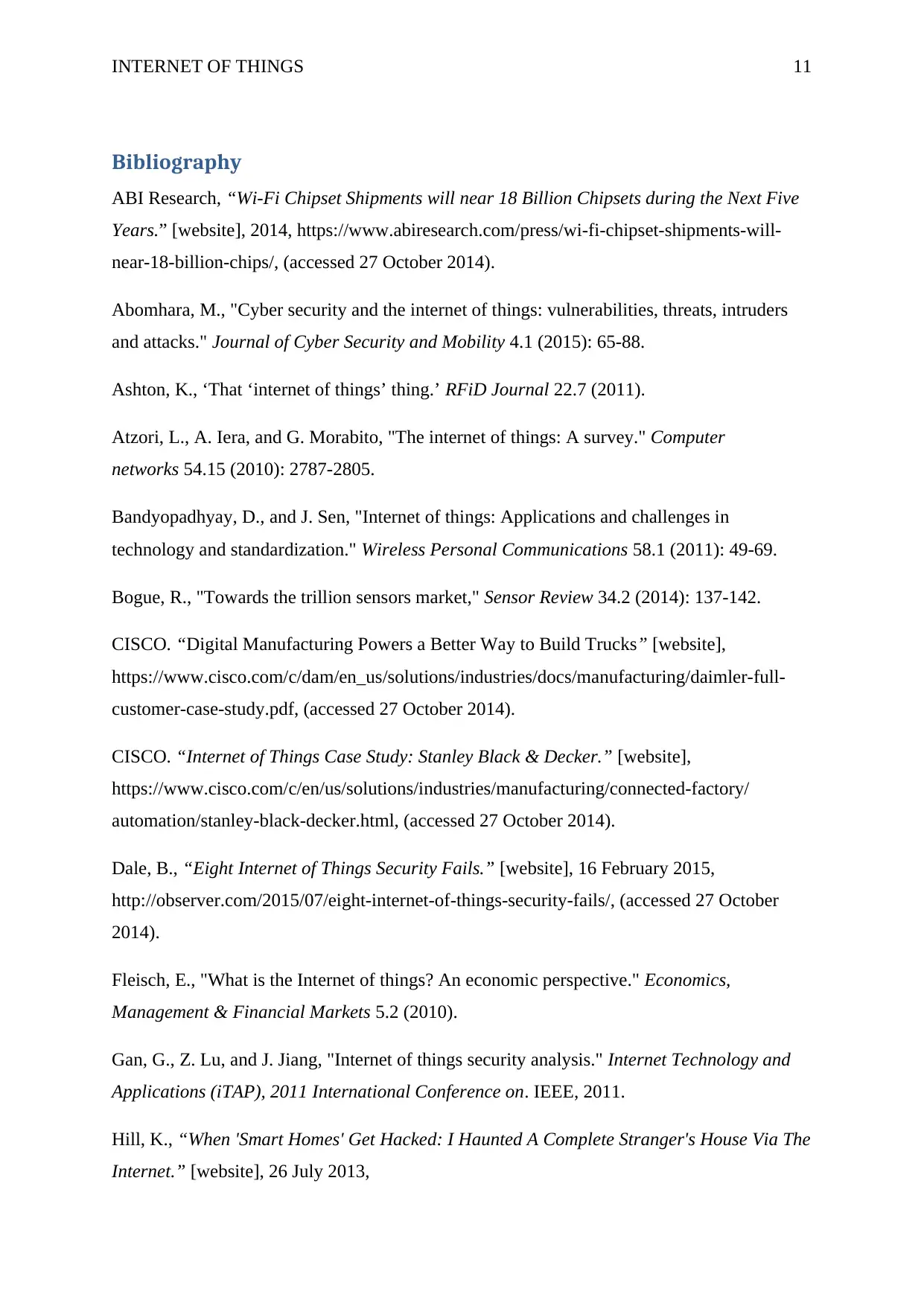
INTERNET OF THINGS 11
Bibliography
ABI Research, “Wi-Fi Chipset Shipments will near 18 Billion Chipsets during the Next Five
Years.” [website], 2014, https://www.abiresearch.com/press/wi-fi-chipset-shipments-will-
near-18-billion-chips/, (accessed 27 October 2014).
Abomhara, M., "Cyber security and the internet of things: vulnerabilities, threats, intruders
and attacks." Journal of Cyber Security and Mobility 4.1 (2015): 65-88.
Ashton, K., ‘That ‘internet of things’ thing.’ RFiD Journal 22.7 (2011).
Atzori, L., A. Iera, and G. Morabito, "The internet of things: A survey." Computer
networks 54.15 (2010): 2787-2805.
Bandyopadhyay, D., and J. Sen, "Internet of things: Applications and challenges in
technology and standardization." Wireless Personal Communications 58.1 (2011): 49-69.
Bogue, R., "Towards the trillion sensors market," Sensor Review 34.2 (2014): 137-142.
CISCO. “Digital Manufacturing Powers a Better Way to Build Trucks” [website],
https://www.cisco.com/c/dam/en_us/solutions/industries/docs/manufacturing/daimler-full-
customer-case-study.pdf, (accessed 27 October 2014).
CISCO. “Internet of Things Case Study: Stanley Black & Decker.” [website],
https://www.cisco.com/c/en/us/solutions/industries/manufacturing/connected-factory/
automation/stanley-black-decker.html, (accessed 27 October 2014).
Dale, B., “Eight Internet of Things Security Fails.” [website], 16 February 2015,
http://observer.com/2015/07/eight-internet-of-things-security-fails/, (accessed 27 October
2014).
Fleisch, E., "What is the Internet of things? An economic perspective." Economics,
Management & Financial Markets 5.2 (2010).
Gan, G., Z. Lu, and J. Jiang, "Internet of things security analysis." Internet Technology and
Applications (iTAP), 2011 International Conference on. IEEE, 2011.
Hill, K., “When 'Smart Homes' Get Hacked: I Haunted A Complete Stranger's House Via The
Internet.” [website], 26 July 2013,
Bibliography
ABI Research, “Wi-Fi Chipset Shipments will near 18 Billion Chipsets during the Next Five
Years.” [website], 2014, https://www.abiresearch.com/press/wi-fi-chipset-shipments-will-
near-18-billion-chips/, (accessed 27 October 2014).
Abomhara, M., "Cyber security and the internet of things: vulnerabilities, threats, intruders
and attacks." Journal of Cyber Security and Mobility 4.1 (2015): 65-88.
Ashton, K., ‘That ‘internet of things’ thing.’ RFiD Journal 22.7 (2011).
Atzori, L., A. Iera, and G. Morabito, "The internet of things: A survey." Computer
networks 54.15 (2010): 2787-2805.
Bandyopadhyay, D., and J. Sen, "Internet of things: Applications and challenges in
technology and standardization." Wireless Personal Communications 58.1 (2011): 49-69.
Bogue, R., "Towards the trillion sensors market," Sensor Review 34.2 (2014): 137-142.
CISCO. “Digital Manufacturing Powers a Better Way to Build Trucks” [website],
https://www.cisco.com/c/dam/en_us/solutions/industries/docs/manufacturing/daimler-full-
customer-case-study.pdf, (accessed 27 October 2014).
CISCO. “Internet of Things Case Study: Stanley Black & Decker.” [website],
https://www.cisco.com/c/en/us/solutions/industries/manufacturing/connected-factory/
automation/stanley-black-decker.html, (accessed 27 October 2014).
Dale, B., “Eight Internet of Things Security Fails.” [website], 16 February 2015,
http://observer.com/2015/07/eight-internet-of-things-security-fails/, (accessed 27 October
2014).
Fleisch, E., "What is the Internet of things? An economic perspective." Economics,
Management & Financial Markets 5.2 (2010).
Gan, G., Z. Lu, and J. Jiang, "Internet of things security analysis." Internet Technology and
Applications (iTAP), 2011 International Conference on. IEEE, 2011.
Hill, K., “When 'Smart Homes' Get Hacked: I Haunted A Complete Stranger's House Via The
Internet.” [website], 26 July 2013,
⊘ This is a preview!⊘
Do you want full access?
Subscribe today to unlock all pages.

Trusted by 1+ million students worldwide
1 out of 14
Related Documents
Your All-in-One AI-Powered Toolkit for Academic Success.
+13062052269
info@desklib.com
Available 24*7 on WhatsApp / Email
![[object Object]](/_next/static/media/star-bottom.7253800d.svg)
Unlock your academic potential
Copyright © 2020–2025 A2Z Services. All Rights Reserved. Developed and managed by ZUCOL.





